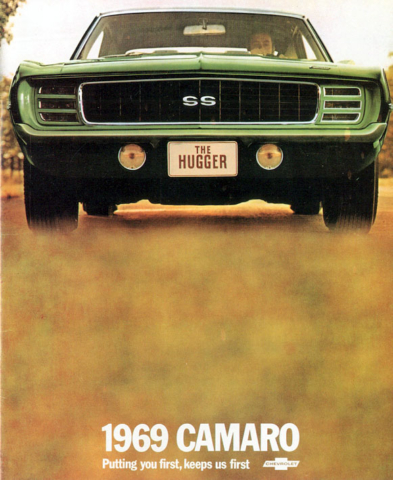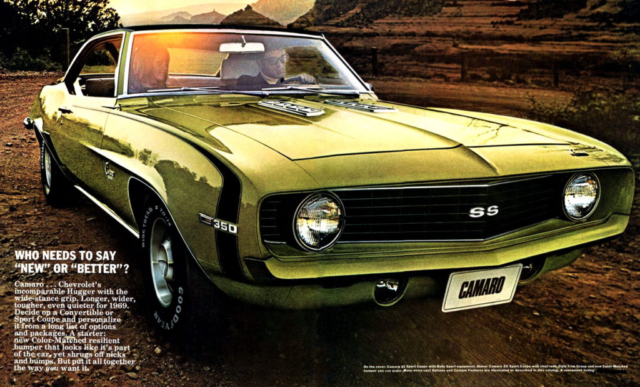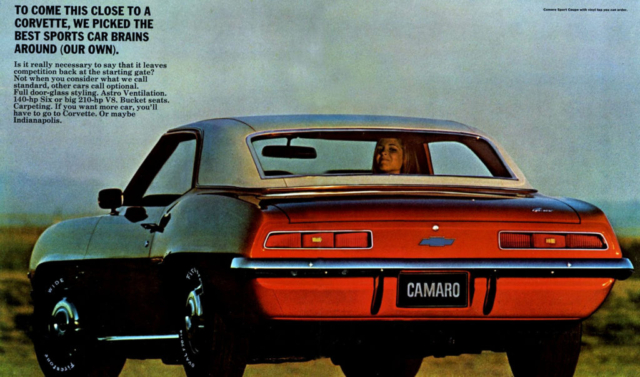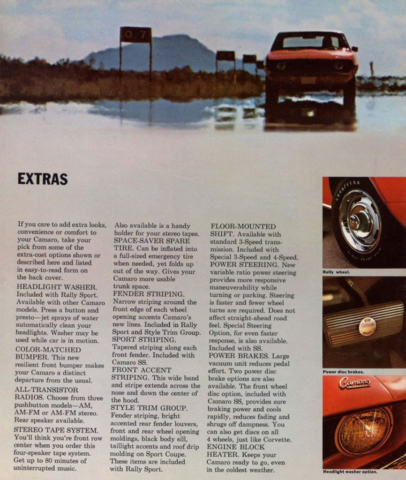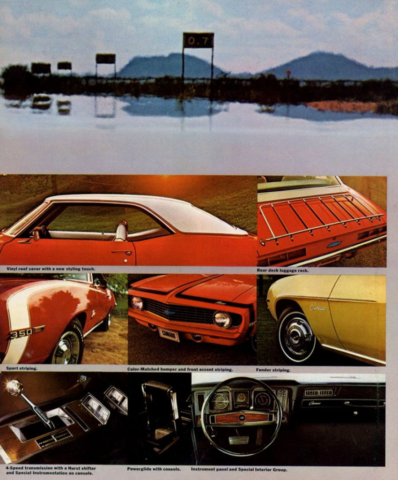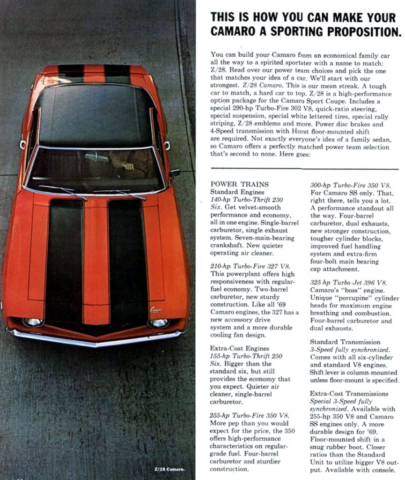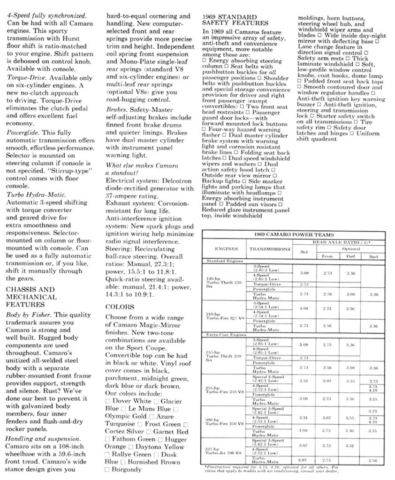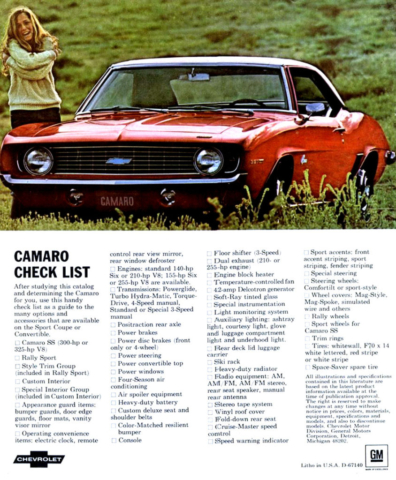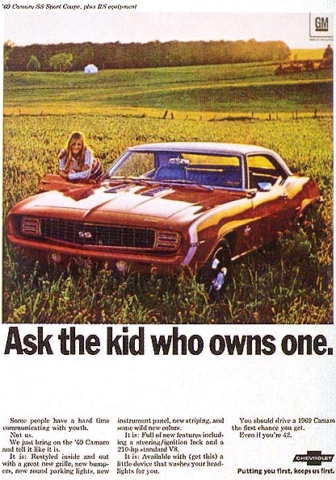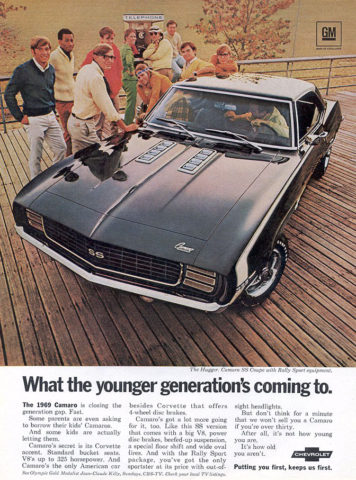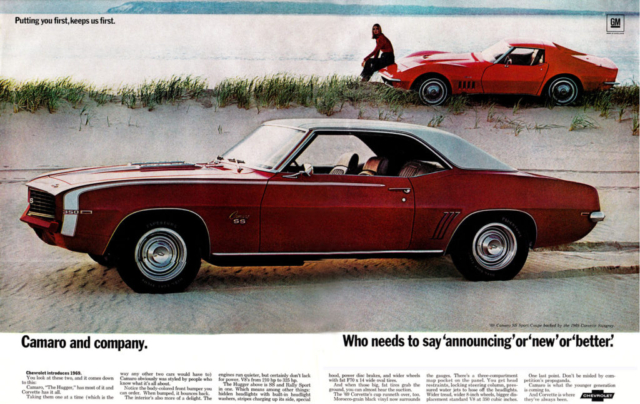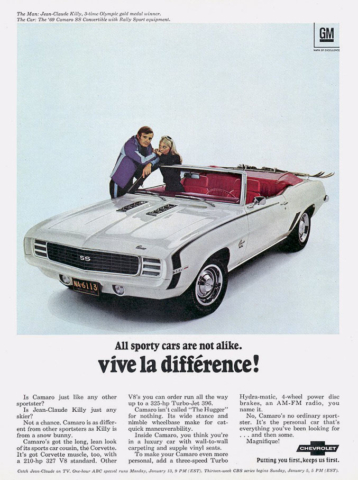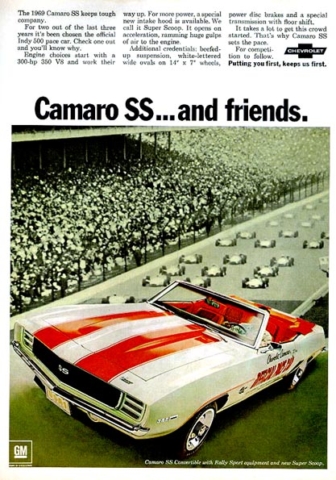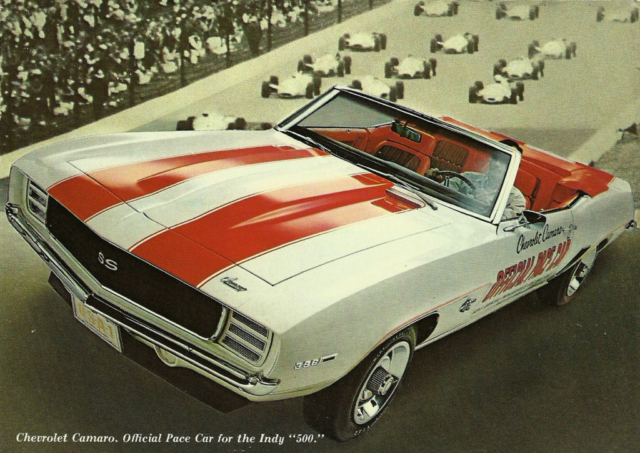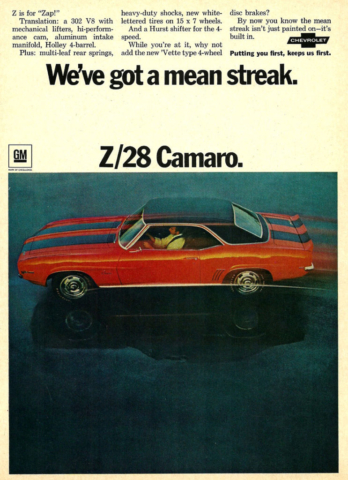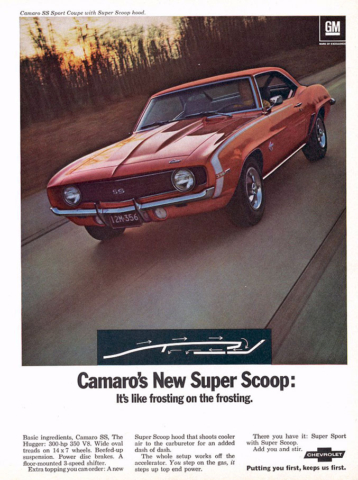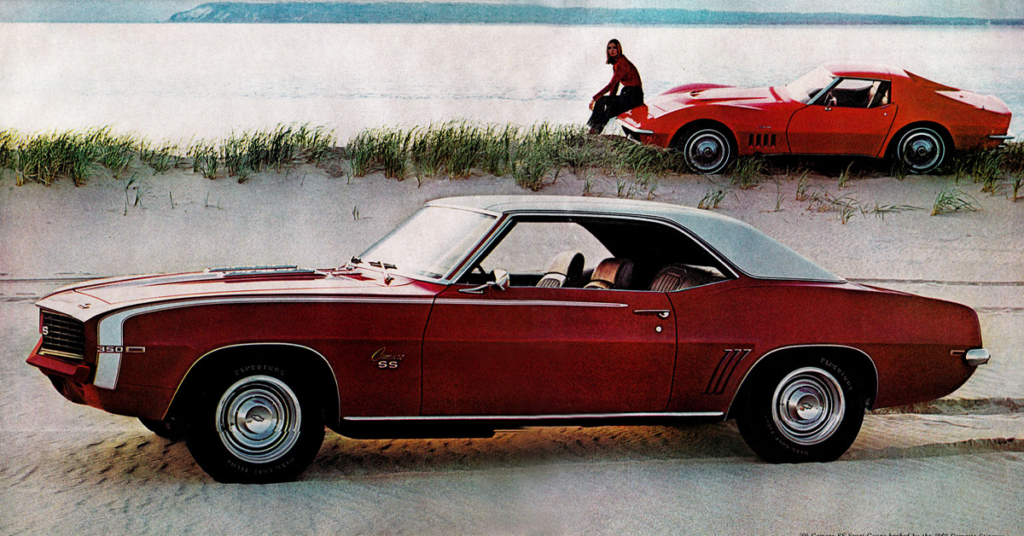
The 1969 Camaro marked the last of the first generation and is arguably the most popular.
While it shared the same basic body style as its earlier siblings, it featured entirely new, more aggressive-looking sheet metal and an entirely revised grille. The familiar coke bottle shape was flattened more to give the 1969 Camaro a lower and wider looking stance. The grille was much more angled, and the parking lamps were moved to the lower front valance below the bumper. Other than the roof, hood, and decklid, the 1969 Camaro doesn’t share very much sheet metal with earlier models.
The 1969 Camaro was available in many different configurations. From a plain-Jane sport coupe to asphalt eating Super Sport, there was something for everyone!
All 1969 Camaros shared the same body unlike the Chevelle and were available in either coupe or convertible. Buyers could choose from the base model Sport Coupe, drag strip ready Super Sport, or road racing Z/28. The Rally Sport option with hidden headlights could be added as a separate appearance package to any model, which could produce an RS/SS or RS/Z28 if so desired. This year also saw the reintroduction of the Indy 500 Pace Car replica.
Interiors were only available with bucket seats and were available in a variety of colors and styles, and headrests would become a standard feature rather than an option.
Slight redesigns were also implemented to distinguish the interior from earlier model years, such as new square gauges and a switch from walnut woodgrain to rosewood when certain options were selected. Standard interiors were available in Black, Dark Blue, Red, White, Light Green, or Dark Metallic Green. Buyers who ordered a deluxe interior received unique door panels with molded-in armrests and Comfortweave seats with color choices of Black, Dark Blue, Light Green, Dark Metallic Green, or Red. Even rarer was the deluxe Houndstooth interior with unique pleats in Black, Orange, Yellow, or White. A fold-down rear seat was available but also very rarely purchased. An optional console was available with or without gauges included.
The buyer could have ordered a number of different exterior colors including Tuxedo Black, Butternut Yellow, Dover White, Dusk Blue, Garnet Red, Glacier Blue, Azure Turquoise, Fathom Green, Frost Green, Burnished Brown, Champagne, Olympic Gold, Burgundy, Cortez Silver, LeMans Blue, Hugger Orange, Daytona Yellow, or Rallye Green. Two-tone color combinations were available in Glacier Blue/Dover White, Azure Turquoise/Dover White, Glacier Blue/Dusk Blue, Dusk Blue/Glacier Blue, Olympic Gold/Dover White, and Burnished Brown/Champagne.
Complementing the wide variety of available colors were the available drive train combinations that could be opted for on the 1969 Camaro, up to fifteen in total.
Base power was had by one of two available six-cylinder engines, the L26 230ci/140hp base L6 or the L22 250ci/155hp optional L6. Buyers who wanted more power could opt for one of the five non-SS V8 offerings, although some of these were only available in either early (up to 1/1/69) or late (after 1/1/69) production cars.
Base V8 choices were either the LF7 327ci/210hp or the L14 307ci/200hp engines, while there were three higher horsepower optional V8s that could be selected. These non-SS options were the L30 327ci/275hp, the LM1 350ci/255hp, or the L65 350ci/250hp small blocks.
Any buyer who selected an SS model Camaro would receive one of potentially 5 available high output V8s. The entry SS350 was the L48 350ci/300hp small block, while an SS396 Camaro received four different big-block 396ci options. These were the L35/L34/L78/L89, which each was respectively rated at 325/350/375 horsepower. The L78 and L89 were both rated to 375 horsepower, but the L89 received aluminum heads whereas the L78 heads were made of cast iron.
In addition, the special Z/28 Camaros were the only trim that offered the exclusive 302ci/290hp small block which was meant to conform to the Trans-Am series’ restrictions regarding engine displacement. Some select dealers had also been using the COPO (Central Office Production Order) system to order high-performance Camaros that were not otherwise available from the factory. These COPO Camaros could either have the L72 427ci/425hp big block or the ZL1 427ci/430hp big block. The main difference between the two consisted of the L72 is an iron block while the ZL1 was an aluminum block.
Transmission choices were nearly as varied as engine choice for 1969.
Previously, the 2-speed Powerglide was the only available automatic for inline 6 and small block V8 Camaros, but 1969 saw the introduction of the optional Turbo Hydramatic TH350 3-speed auto for these applications. Big blocks would instead receive the Turbo Hydramatic TH400 3-speed automatic as it could withstand the higher torque these engines produced.
Manual transmissions were available as either 3 or 4-speeds, column or floor shifter. The base manual trans was a Saginaw M15 3-speed, which was generally a column shifted unit. A heavy-duty Muncie MC1 floor shifted 3-speed was the standard manual transmission offered on SS and LM1 350ci small-block optioned Camaros.
When a 4-speed manual was ordered on a lower performance engine, a Saginaw M20 was the transmission that was used. The Muncie M20 wide-ratio 4-speed was the standard 4-speed manual offered for higher performance engines. The close-ratio Muncie M21 became available starting with the L34 396ci/350hp engine and above, while the range-topping HD Muncie M22 “rock crusher” was only available as an option on L78/L89/Z28/COPO equipped Camaros.
About 243,000 1969 Camaros were produced in total for the model year. Due to delays with the redesigned 1970 second-generation Camaro, the 1969 production was extended four months to run up until November 1969.
1969 Camaro OEM Brochures & Ads
1969 Camaro Model Options
Models & Body Styles
- 1969 Camaro Standard Sport Coupe & Convertible
- 1969 Camaro Rally Sport (Appearance Package)
- 1969 Camaro Super Sport Coupe & Convertible
- 1969 Camaro Rally Sport Super Sport Coupe & Convertible (RS/SS)
- 1969 Camaro Z/28 Coupe Only
- 1969 Camaro Rally Sport Z/28 (RS/Z/28) Coupe Only
- 1969 Camaro ZL1 – COPO Special Order (Only 69 produced for 1969)
Engine Options
- 230 cubic inches 140 horsepower 6-cylinder (Base L6)
- L22 – 250 cubic inch 155 horsepower 6-cylinder (optional)
- Z/28 – 302 cubic inch 290 horsepower V8 (Only available on Z/28 equipped cars)
- 307 cubic inch 200 horsepower V8 (Base V8)
- LF3 – 327 cubic inch 210 horsepower V8 (LF3 was superseded by the 307 V8 as 1969’s base V8)
- L65 – 350 cubic inch 250 horsepower V8 (optional)
- L48 – 350 cubic inch 300 horsepower V8 (Base for SS Models)
- L35 – 396 cubic inch 325 horsepower V8 (optional)
- L34 – 396 cubic inch 350 horsepower V8 (optional)
- L78 – 396 cubic inch 375 horsepower V8 (optional)
- L89 – 396 cubic inch 375 horsepower V8 (optional)
- ZL1 – 427 cubic inch 425 horsepower V8 (COPO)
*The optional Z/28 package offered an exclusive 302ci/290hp small block which was meant to conform to the Trans Am series’ restrictions regarding engine displacement.
L89 differed from L78 in having aluminum heads, larger valves, a specific Holley carburetor, & a different transmission.
Only 50 ZL1’s, the aluminum-block 427, were installed in Camaros by the factory, leaving an additional 19 that were dealer installed.
Available Transmissions:
Automatic:
- 2-speed Torque-Drive
- Turbo Hydramatic TH350 3-speed
- Turbo Hydramatic TH400 3-speed
Manual:
- Saginaw M15 3-speed
- Heavy-duty Muncie MC1 3-speed
- Saginaw M20 4-speed
- Muncie M21 4-speed
- Heavy-duty Muncie M22 4-speed “Rock Crusher”
Production Numbers:
- Base Models: 165,226
- Convertibles: 15,573
- Z/28: 20,302
- Rally Sport: 37,773
- Super Sport: 36,309
- Pace Cars: 3,675
- ZL1: 69
Total production for the 1969 model year: 280,858
*These figures are combined in some instances as one could have ordered an RS/SS or an RS/Z28
Dimensions & Capacities:
Length: 186.0 inches
Width: 74.0 inches
Height:
- Coupe: 51.5 inches
- Convertible: 50.9 inches
Wheelbase: 108.0 inches

Because desirable models like Z/28s, Pace Car replicas and SS396s are easily cloned, Bowtie enthusiasts should carefully inspect any potential garage additions; VIN and trim plates are easily decoded for authenticity.
Vehicle Identification Example: 123379N500001
* Third digit is engine code: 3 = 6-cylinder, 4 = V8
* Fourth digit is body style: 3 = Coupe, 6 = Convertible
* Sixth digit is model year: 9 = 1969
* Seventh digit is N for Norwood assembly, L for Van Nuys.
* Last six digits increased one with each car built at each plant.
Learn to decode your pre-1981 GM vin code!
1969 Camaro Engine Codes & Specs
Available Engine Specifications
6-Cylinder Engine Codes
8-Cylinder Engine Codes
Block Casting:
- 302 ci: 3932386, 3956618, 3970010
- 307 ci: 3914636, 3970020
- 327 ci: 3956618
- 350 ci: 3932386, 3956618, 3970010
- 396 ci: 3866961, 3937726, 3955272, 3965449, 3969854
- 427 ci: 3946052, 3946053, 3963512
Available Transmission Specifications
Transmission Codes
Torque-Drive Transmission
Powerglide Transmission
Turbo Hydramatic 350 Transmission
3-Speed Manual Transmission
4-Speed Manual Transmission
Available Rear Axle Code Specifications
1969 Camaro Factory Options
Regular Production Option (RPO)
1969 Camaro Color Options
Exterior & Interior Color Combinations
Interior Codes: 711=Bk/S, 712=Bk/C, 713=Bh/C, 714=Yh/C, 715=B/S, 716=B/C, 718=R/S, 719=R/C, 720=0h/C, 721=Mg/S, 722=Mg/C, 723=Dg/S, 725=Dg/C, 727=Ib/S, 729=Ih/C.
Abbreviations: B = Blue, Bh = Black Hounds tooth, Bk = Black, C = Custom, Dg = Dark Green, Ib = lvory/Black, Ih = lvory/Hounds tooth, Mg = Medium Green, Oh = Orange/Hounds tooth, R = Red, S = Standard, W = White, Yh = Yellow/Hounds tooth.
Vinyl & Convertible Top Colors

